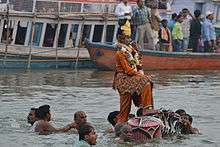Kaliya

Kaliya (IAST:Kāliya, Devanagari: कालिय), in Hindu traditions, was a poisonous Naga living in the Yamuna river, in Vrindavan. The water of the Yamuna for four leagues all around him boiled and bubbled with poison. No bird or beast could go near, and only one solitary Kadamba tree grew on the river bank. It is association with Lord Krishna dancing and subduing the snake which is celebrated as Nag Nathaiya or Nag Nrithya.
The proper home of Kāliya was Ramanaka Dwipa, but he had been driven away from there by fear of Garuda, the foe of all serpents. Garuda had been cursed by a yogi dwelling at Vrindavan so that he could not come to Vrindavan without meeting his death. Therefore, Kāliya chose Vrindavan as his residence, knowing it was the only place where Garuda could not come.
Once Krishna and herd boys were playing ball, the ball fell into the Yamuna river and Krishna jumped after it. Kāliya rose up with his hundred and ten hoods vomiting poison. All the Gopis and people of Nandagokula got tensed and came running towards the Yamuna bank as soon as they heard the news that Krishana jumped into the river where the dangerous Kaliya was staying. Meanwhile, in the bottom of the river, Kaliya wrapped himself around Krishna's body. Krishna became so huge that Kāliya had to release him. He immediately regained his original form, and when he saw the Brij folk were so much afraid he suddenly sprang into Kāliya's head and assumed the weight of the whole universe, and danced on the naga's heads, beating time with his feet. Kaliya started vomiting blood and slowly began to die. But then the naga's wives came and prayed to Krishna with joined palms, worshipping Krishna and praying for mercy for their husband. Kāliya, recognizing the greatness of Krishna, surrendered, promising he would not harass anybody. So Krishna pardoned him and then let him go free. Krishna asked Kaliya to leave the river and go to Ramanaka Dwipa. Ramanaka Dwipa is identified as Fiji.[1]
The people who had gathered on the banks of Yamuna were terrified looking at the colour of water which was changing to poison colour. Slowly,Krishna rose up from the bottom of the lake dancing on the head of Kaliya. When they saw Krishna, everyone were happy and they were thrown into an ecstatic dance performance on the heads of Kaliya. This episode is remembered as the 'Kalinga Nartana' in South India.
And at the last as per puranas kaliya was pushed into patala loka and is there till today.


History

The history of Krishna and Kāliya is told in Chapter Sixteen of the Tenth Canto of the Bhagavata Purana. Kaliya,is also a rajpot caste in India.

In Punjab there were two small states of rulers belonging to this Kaliraman. These were Sinpura and Bhagowal.
From Mathura they went to Kabul-Ghazni with other Jats - Yadavas. They founded the Kingdom of Garh - Ghazni. During rise of Islam they came back to Bhatner- Sirsa. According to their bards they founded the old village of Patan and Siswad. From Patan Chaudhary Sishu came to Sisai. His brother Sunda founded village Sandwa and Salaywala.
Oothukkadu in Tamil Nadu, TIRUVARUR district, is said to have a svayambhu (self-formed) image of this scene.
See also
References
- Sister Nivedita & Ananda K.Coomaraswamy: Myths and Legends of the Hindus and Bhuddhists, Kolkata, 2001 ISBN 81-7505-197-3
External links
| Wikimedia Commons has media related to Kaliya. |
- Bhagavata Purana, Canto Ten, Chapter 16 The account of Krishna and Kaliya, as told in the Bhagavata Purana. (Full Sanskrit text online, with translation and commentary.)
- The Importance of Kaaleya Mardan - A comparative view of the knowledge of solar physics and biology among the modern scientists, among the ancient civilized nations, and among the early Sanskrit writers.
